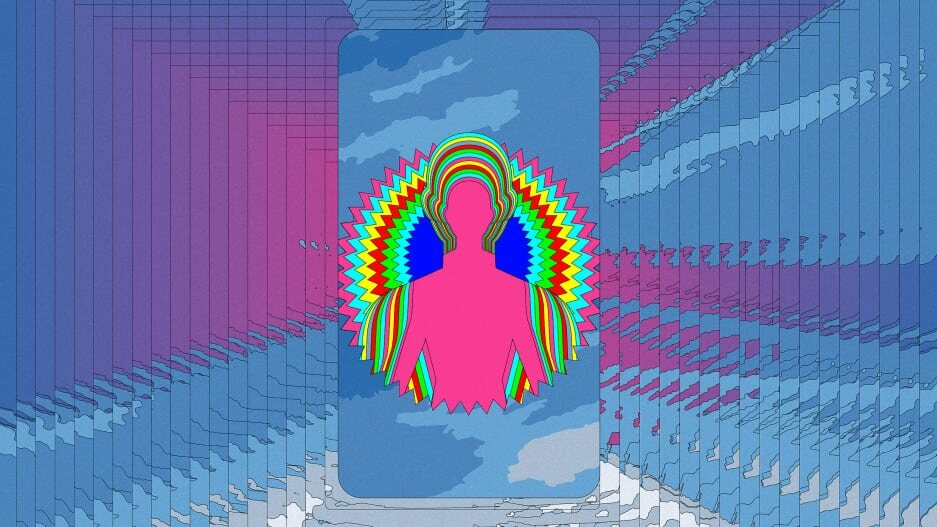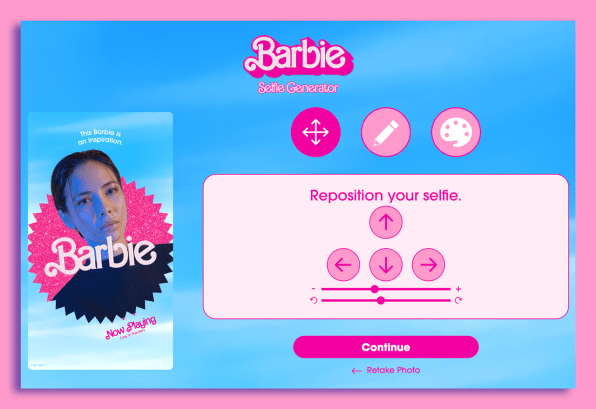- | 8:00 am
How ‘Barbie’ hype got an AI boost
The blockbuster movie shows how AI can amplify human creativity to massive effect.

The movie Barbie, which was released over the weekend, has been saturating social media, the airwaves, and publishing outlets for months. And in a year that’s been defined by the emergence of generative AI, it’s appropriate that 2023’s buzziest summer flick has been infused with the technology.
Just as AI conversation was reaching a fever pitch in the U.S., the Mattel-owned brand released the Barbie Selfie Generator tool, which converts users’ photos into Barbie movie posters. In mid-spring, content from the AI-infused tool was going viral and producing 67% positive online conversations while seeing a 23,350% increase in mentions during one week in April. Since then, the #barbiemovie hashtag has garnered more than 325,000 posts on Instagram alone. This kind of consumer engagement is why Barbie broke box office records with a $155 million opening weekend.

The movie underscores how creativity and technology must complement each other in the AI era. Here are three takeaways for company leaders about what part tech has played in Barbie being the talk of the summer.
CAPITALIZE ON AI’S OPPORTUNITIES
In recent months, tech observers have drawn parallels between AI and a reliable work companion, a professional assistant, or even a sidekick that enhances our job performance. But some worry about AI taking jobs out of creatives’ hands.
With all that in mind, the Barbie team’s approach to AI didn’t take away creativity from creatives and hand the responsibility to technology; instead, it allowed the brand’s fans and those who were looking forward to the movie to participate in creating fun content. Meanwhile, Mattel’s in-house marketing team and third-party ad agencies were busy making content for digital, TV, radio, and other media channels to the tune of a $100 million budget. In other words, the creatives were busy with tons of content and were wise enough to include technology to help their cause—which is to spread the word about the movie.
The transformation brought about by AI doesn’t have to involve replacing humans. Rather, it can handle ideas that humans cannot do at scale, like automating user-generated content (UGC) —and streamlining mundane tasks for creatives as a way to free up valuable time for more fulfilling and inspiring work. It’s all about capitalizing on the opportunity instead of fearing tech.
WELCOME PARTICIPANTS, ONE AND ALL
While countless consumers were drawn to the Barbie Selfie Generator tool, this movie shows how AI’s reach goes beyond a well-planned marketing tactic. Sometimes brands do not even have to initiate the activity, as influencers big and small seek new ways to drive engagement among their personal followers. AI, it turns out, can make participation easier for everyone—even fashion-magazine-cover models.
Take Lisa Opie, a former Miss Virgin Islands, who appears on the August cover of Glamour Bulgaria as a futuristic Barbie. Her cover has garnered buzz because AI helped the model do the photo shoot in just 20 minutes. And Opie, who has 1 million Instagram followers, has inspired tens of thousands of “likes” on the social platform with a few posts about the Barbie shoot to her personal account.
The takeaway for creatives: consider how AI can be used not only with internal design work and inspiring consumers to share content; it is also a new medium for the sort of organic buzz that truly cements brands in culture. The “wow” factor of Opie’s magazine shoot is just the tip of the iceberg. Partnering with influencers who embrace AI—if they use it in interesting ways in the production process—can bolster brands because it gives the media something genuinely interesting to report on and consumers something fun to ponder. The upshot is awareness without feeling advertised to—it’s branding that feels relevant and provocative.
GET INVOLVED BEYOND THE “BIG IDEA“
All of which raises the question: As Barbie and other brands increasingly leverage AI, what does that mean for creatives? As certain—more menial—tasks become automated through technologies like AI, it opens up new opportunities for creatives to get involved in the broader lifecycle of campaigns, and opens possibilities for dynamic, evolving activations rather than static deliverables.
On the process and technology side, there is a massive amount they can do to shape how tools like AI are created and used. Creatives should have a say in the workflows that AI tools are utilized in, the ethical and creative frameworks that shape how they are used, when they are used, and why they are used. And in terms of the work, the data that is accessible both through existing AI tools and the data that comes out of activations enables creatives to iterate faster and be more adaptable and flexible. Ultimately, they can have a greater influence on the entire campaign—and not just the “big idea.”
This is the bold, new world creatives now operate in. And while the Barbie movie didn’t create this world, the masterminds behind the hype have shown us how AI can complement the best in human creativity.





































